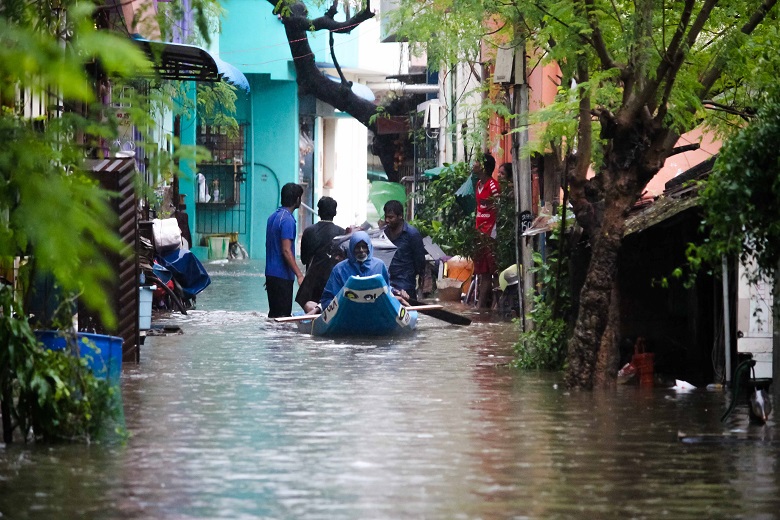Trending Now
- IPL 2024 begins with a bang. First contest between CSK and RCB.
- Election commission allots mike symbol to Naam Thamizhar Katchi
- AIADMK promises to urge for AIIMS in Coimbatore, in its election manifesto.
- Ponmudi becomes higher education minister.
Columns
Seven ways we can fight back against flooding
![]() February 9, 2016
February 9, 2016
There is no panacea for flood events, but there a range of things we can either do better or start doing to mitigate or adapt to them.
The recent UK floods caused by Storm Desmond in the first week of December 2015 were devastating on both sides of the Pennines. A record-breaking 341mm of rain fell in 24 hours, and 405mm in 48 hours – another record. Tens of thousands of people had to evacuate their homes, there was widespread power loss after two substations were flooded, and transport links were shut down across the region.
What made this flood especially severe is that the previous two months were very wet. Extreme weather events such as Storm Desmond tend not to occur in isolation and nor are they evenly spaced out. In Cumbria there had already been a cluster of previous storms and this was the big one.
To manage such large floods we need to understand the sequence of events that occurs during a period of intense rainfall and how this may be changing. But we also need to learn to deal with the flood waters in ways that are affordable and sustainable.
1. Get to grips with climate change
Every time an extreme weather event takes place, such as a flood or drought, people ask “was that caused by climate change?” A better question to ask is “How much more likely are these events under a changed climate?” So, if such a large event used to have an annual probability of occurrence of 1%, and that has now gone up to 2%, we could say that climate change has doubled the probability of it happening. This is crucial in preparing for future extreme weather events.
2. Make forecasting smarter
There is a global push for cities to become “smart” in everything from traffic flows and energy use to weather hazards by gathering and analysing more real time data. But more specifically for flooding, water sensor networks and advanced weather radar stations (local versions of what the Met Office and the Environment Agency already use across the UK) could help forecast extreme weather, giving communities more time to prepare.
3. Improve catchment management
To combat the severe flooding that took place in Cumbria, rural land management alone is not sufficient. The level of flooding was so enormous that the entire landscape was saturated and any features installed to store or slow water, such as ponds or channels, would have been filled. But this kind of natural flood management has a key role to play in reducing small- to medium-sized floods. Green space, green roof tops, trees, permeable surfaces and above-ground water storage all can play a part. But they must be planned strategically to make an impact on surface flooding.
4. Make best use of flood defences
Towns and cities such as Keswick and Carlisle are defended by purpose-designed “hard” defences such as flood walls and embankments. These play a crucial role in defending populated areas, but only to a designed standard of protection (usually 1 in 100-year floods). Alarmingly, the defences in Cumbria recently had been upgraded to our best estimates of this level of hazard, so a reassessment is clearly needed. But we also need to assess the feasibility and cost of raising these defences further, as there may be limits to how high they can be built and other options may now be preferable.
5. Get strategic about large-scale water storage
Kielder Water is the largest reservoir in the UK, holding 200 billion litres of water. In the winter, the reservoir levels are usually reduced to create space to store rainfall and prevent spills, which cannot be used to generate hydroelectricity. But even this was not enough to withstand the heavy rains of Storm Desmond. If reliable forecasts of heavy rainfall were available well in advance, the reservoir could be partially emptied to make even more space. This could significantly alleviate flooding downstream. But a balance must be found between energy generation, storing water as a resource and managing large flood events.
6. Look at rural solutions
Using agricultural land to store water to protect cities has never been widely promoted in the UK. In fact, our 20th century flood strategy began with the aim of protecting agricultural land from flooding. But water storage on upstream areas provides a new opportunity for us to take action. Countries that experience regular monsoon flooding, particularly in Asia, often sacrifice farm land for weeks at a time to curb flows and prevent loss of life and damage. Deliberately flooding the upstream area to avoid the flood wave rushing down towards lowland cities – if done with the cooperation of landowners and farmers – could be one of our best defences against large-scale flooding.
7. Learn to live with the floods
It is not possible for all settlements to simply seal themselves off from their environment, and learning to live with floods is inevitable. Whether through local catchment-management initiatives, community flood defence schemes, retrofitting homes, stronger development control or phased resettlement as we move into a new era of flood risk, we all need to be more flood aware.
The Conversation
Chris Kilsby, Professor of hydrology and climate change, Newcastle University
Disclaimer:The views expressed above are the author’s own






















